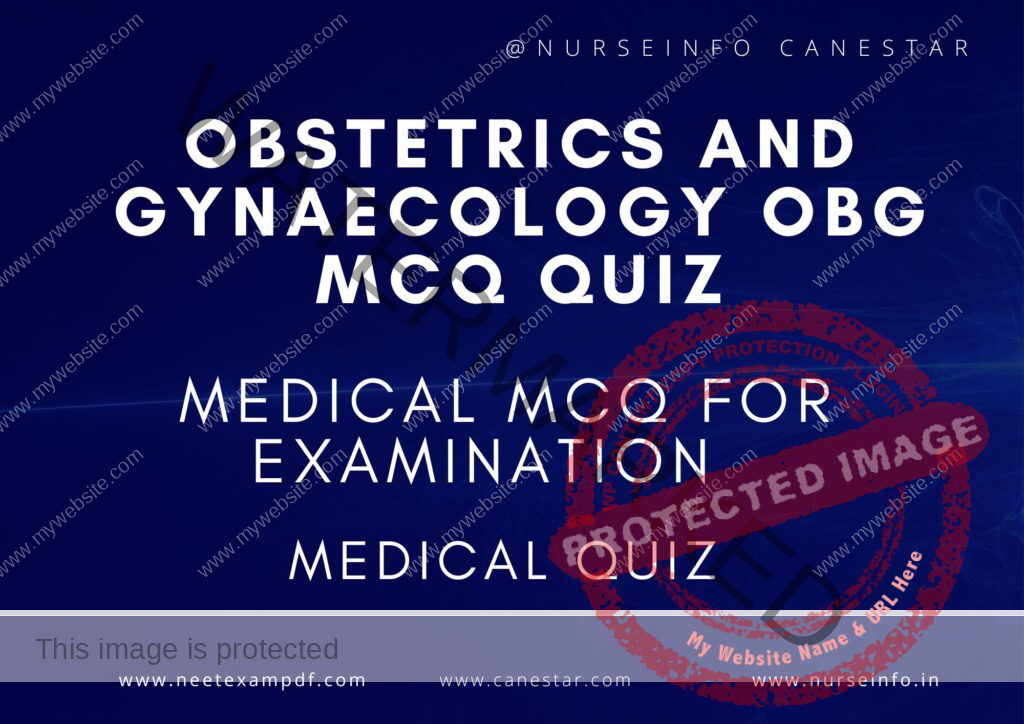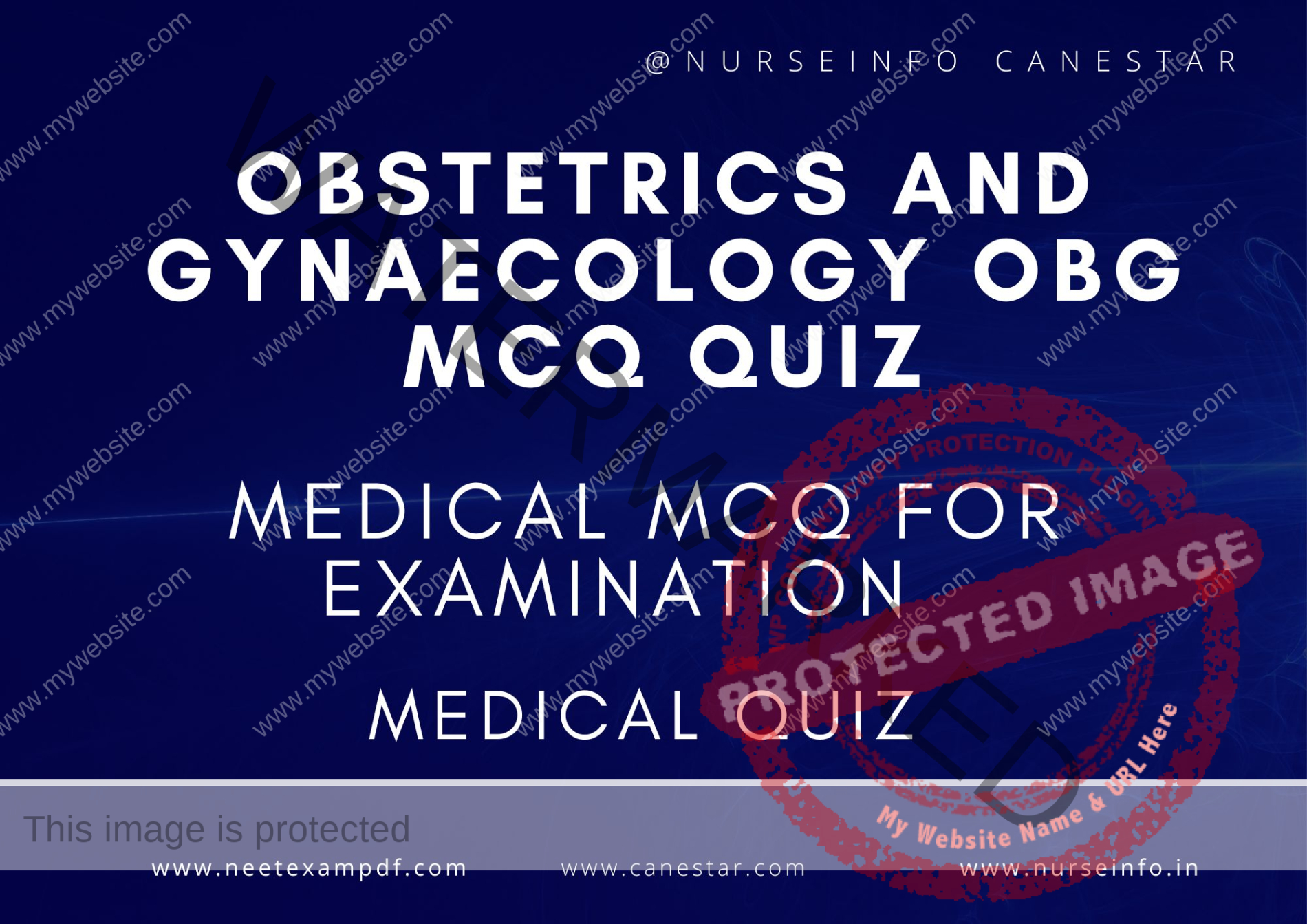MULTIPLE CHOICE QUESTIONS ON Obstetrics and Gynaecology OBG QUIZ – MCQS WITH RATIONALE ANSWER – Obstetrics and Gynaecology OBG MCQ QUESTIONS WITH RATIONALE
MCQ FOR Obstetrics and Gynaecology OBG QUIZ
These mcqs are prepared exclusively for medical professionals for exam preparation. MCQ is helpful to remember the concept on Obstetrics and Gynaecology OBG mcq quiz. This multiple choice questions are helpful for preparation for DHA, PROMETRIC, MOH, HAAD, NCLEX, Medical, NEET and Nursing EXAMINATION
Obstetrics and Gynaecology OBG MCQ QUIZ
Obstetrics and Gynecology (OBG) MCQs with Rationale Answers
What is the term used for the first perception of fetal movement by the mother?
a) Quickening
b) Lightening
c) Engagement
d) Crowning
Answer: a) Quickening
Rationale: Quickening is the term used to describe the first feeling of fetal movement by the mother, usually occurring between 18-20 weeks of gestation in a first pregnancy.
Which hormone is primarily responsible for maintaining the corpus luteum during early pregnancy?
a) Estrogen
b) Progesterone
c) Human chorionic gonadotropin (hCG)
d) Oxytocin
Answer: c) Human chorionic gonadotropin (hCG)
Rationale: hCG, produced by the placenta, maintains the corpus luteum in early pregnancy, ensuring the continued production of progesterone to support the uterine lining.
What is the normal duration of a menstrual cycle?
a) 14-20 days
b) 21-35 days
c) 28-40 days
d) 35-50 days
Answer: b) 21-35 days
Rationale: The normal menstrual cycle length ranges from 21 to 35 days, with an average of 28 days, depending on the individual.
Which stage of labor involves the delivery of the baby?
a) First stage
b) Second stage
c) Third stage
d) Fourth stage
Answer: b) Second stage
Rationale: The second stage of labor begins with full cervical dilation and ends with the delivery of the baby.
What is the most common cause of postpartum hemorrhage?
a) Retained placenta
b) Uterine atony
c) Cervical laceration
d) Coagulation disorders
Answer: b) Uterine atony
Rationale: Uterine atony, the failure of the uterus to contract effectively after delivery, is the most common cause of postpartum hemorrhage.
Which test is used to diagnose gestational diabetes?
a) Fasting blood glucose test
b) Oral glucose tolerance test (OGTT)
c) Hemoglobin A1c test
d) Random blood glucose test
Answer: b) Oral glucose tolerance test (OGTT)
Rationale: The OGTT is used to diagnose gestational diabetes, typically performed between 24-28 weeks of gestation.
What is the recommended treatment for bacterial vaginosis in pregnancy?
a) Oral metronidazole
b) Topical clotrimazole
c) Oral fluconazole
d) Intravenous penicillin
Answer: a) Oral metronidazole
Rationale: Oral metronidazole is the recommended treatment for bacterial vaginosis during pregnancy to avoid complications such as preterm labor.
What is the name of the structure that connects the fetus to the placenta?
a) Amniotic sac
b) Umbilical cord
c) Chorionic villi
d) Yolk sac
Answer: b) Umbilical cord
Rationale: The umbilical cord connects the fetus to the placenta, allowing the exchange of nutrients, gases, and waste products between the mother and fetus.
Which condition is characterized by high blood pressure and proteinuria after 20 weeks of gestation?
a) Gestational hypertension
b) Eclampsia
c) Preeclampsia
d) Chronic hypertension
Answer: c) Preeclampsia
Rationale: Preeclampsia is characterized by high blood pressure and proteinuria after 20 weeks of gestation and can lead to serious complications if untreated.
Which type of ovarian cyst is most commonly associated with early pregnancy?
a) Dermoid cyst
b) Follicular cyst
c) Corpus luteum cyst
d) Endometrioma
Answer: c) Corpus luteum cyst
Rationale: A corpus luteum cyst can form after ovulation and is often seen in early pregnancy as it produces progesterone to support the uterine lining.
What is the purpose of a non-stress test (NST) in pregnancy?
a) To evaluate fetal movement
b) To measure amniotic fluid volume
c) To assess fetal heart rate in response to movement
d) To detect fetal anomalies
Answer: c) To assess fetal heart rate in response to movement
Rationale: An NST monitors the fetal heart rate and its variability in response to fetal movements, providing information about fetal well-being.
Which hormone is responsible for the relaxation of the pelvic ligaments during pregnancy?
a) Progesterone
b) Estrogen
c) Relaxin
d) Prolactin
Answer: c) Relaxin
Rationale: Relaxin is produced during pregnancy to relax the pelvic ligaments and prepare the birth canal for delivery.
Which term describes the surgical incision made in the perineum to enlarge the vaginal opening during childbirth?
a) Episiotomy
b) Laparotomy
c) Hysterectomy
d) Salpingectomy
Answer: a) Episiotomy
Rationale: An episiotomy is a surgical incision made in the perineum to facilitate childbirth by enlarging the vaginal opening.
What is the primary function of the placenta?
a) To produce amniotic fluid
b) To provide oxygen and nutrients to the fetus
c) To produce milk
d) To facilitate fetal movements
Answer: b) To provide oxygen and nutrients to the fetus
Rationale: The placenta facilitates the exchange of oxygen, nutrients, and waste products between the mother and fetus.
Which condition is characterized by implantation of the fertilized egg outside the uterine cavity?
a) Ectopic pregnancy
b) Molar pregnancy
c) Blighted ovum
d) Missed abortion
Answer: a) Ectopic pregnancy
Rationale: An ectopic pregnancy occurs when the fertilized egg implants outside the uterine cavity, commonly in the fallopian tube, and can be life-threatening if not treated.
Which fetal heart rate pattern is considered normal during labor?
a) Bradycardia
b) Tachycardia
c) Early decelerations
d) Late decelerations
Answer: c) Early decelerations
Rationale: Early decelerations are a normal finding during labor, typically indicating head compression and not associated with fetal distress.
What is the term for the first milk produced by the mammary glands after childbirth?
a) Colostrum
b) Lactose
c) Meconium
d) Hindmilk
Answer: a) Colostrum
Rationale: Colostrum is the first milk produced after childbirth, rich in antibodies and nutrients to support the newborn’s immune system.
Which term refers to the absence of menstrual periods?
a) Dysmenorrhea
b) Amenorrhea
c) Menorrhagia
d) Oligomenorrhea
Answer: b) Amenorrhea
Rationale: Amenorrhea is the absence of menstrual periods, which can be caused by various physiological or pathological conditions.
Which condition involves the growth of endometrial tissue outside the uterus?
a) Fibroids
b) Adenomyosis
c) Endometriosis
d) Polycystic ovary syndrome (PCOS)
Answer: c) Endometriosis
Rationale: Endometriosis is a condition where endometrial tissue grows outside the uterus, often causing pain and infertility.
What is the purpose of administering Rh immunoglobulin (RhIg) to an Rh-negative pregnant woman?
a) To treat anemia
b) To prevent Rh sensitization
c) To enhance fetal lung maturity
d) To manage hypertension
Answer: b) To prevent Rh sensitization
Rationale: Rh immunoglobulin is given to Rh-negative pregnant women to prevent the development of antibodies against Rh-positive fetal blood cells, which could cause hemolytic disease in future pregnancies.


